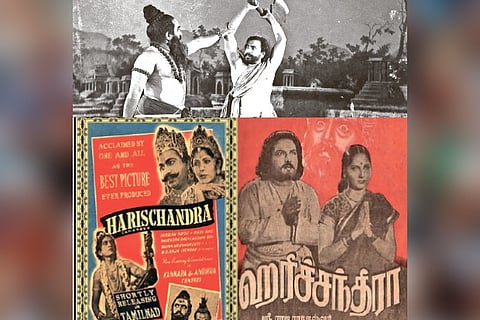

Chennai
But in the Madras theatres of 1944, Harichandra did fight and ironically, against another Harichandra. Silent films had no borders as long as the narrator spoke in the local dialect. But once the cinema talked in India in 1930, regional language films had highly restricted viewership based on linguistic borders and producers perpetually walked the tightrope trying to make ends meet. The weather-beaten story of Harichandra had been made by hundreds of drama companies (the Mahatma saw the SVS play in Victoria Public Hall during one of his early visits). It had been filmed as a Tamil talkie twice in the 1930s and countless times as silent movies. The story and scenes were familiar to Tamil viewers and Pammal Sambanda Mudaliar had even written a spoof. He twisted the names of the original characters and their behaviour as well. Chandra Hari (a wordplay) acted by NS Krishnan on the screen had a king who never spoke the truth as a matter of principle. Audiences rolled on the floor in laughter at the parody.
A shrewd businessman like AVM never would have thought of making a Harichandra in Tamil. But he wasn’t one awed by language differences. He had just made a Telugu movie called Boo Kailas with Kannada actors and a Marathi director. To add to the brew, the movie eulogised the greatest villain in mythology — Ravana. Shooting in a haunted palace in Mandaveli, Madras, AVM made a Kannada movie on Harichandra. He identified Sri Sahitya Samrajya Nataka Mandali — a Kannada theatre team of Mysore as his content partners. Theatre artist Rattihalli Nagendra Rao directed the film besides acting in it (he starred in the first Kannada talkie and continued acting for 40 years). The film was a hit in Mysore state and in Kannada speaking areas of Madras presidency like Dharwad where it ran for 100 days.
AVM’s sound department was headed by a brilliant audio engineer Srinivasa Raghavan. He had a brainwave while watching the rushes of the Kannada film.
In a talkie, words spoken by actors and the background music were recorded on separate tracks. Raghavan realised that if somebody spoke in another language harmonising the lip movement of the actors and made logic on screen he could have a full-length movie in another language.
He took some colleagues in the studio into confidence, erased the original dialogue track in one reel of the movie and wrote substitute words in Tamil. Some of the dialogues were even nonsensical but fitted exactly to the lip movement of the actors. With this in hand, he charged into Meiyappan’s room. Meiyappan already had the bad luck of having a movie flop because the sound and the picture did not synchronise due to a camera choice error.
But this time, Meiyappan was impressed with the endeavour mainly because the economics of dubbing stunned the entrepreneur within. A movie could now be released in assorted territories within a fractional cost of producing a new one. It was too seductive to disregard.
But, not willing to take more chances than what he should, Meiyappan had the Kannada director sit next to the Tamil dialogue writer to get the translation and nuances right and even used the original Kannada actors gave their voices in Tamil. But most of all, AVM wanted the project to be highly confidential and completed in a jiffy. There was a reason.
Meiyappan had industry information that another film on Harichandra was being shot in Tamil just a few miles away in Gemini Studio and nearing completion. He was aware of the star value of the ‘other’ Harichandra. Versatile actress Kannamba was producing the film and playing Chandramathi’s role for the second time in cinema. Her recent film Kannagi had established her as an actress known for intense heroine roles. The hero PU Chinnappa was attaining superstardom on a parallel trajectory as MK Thyagaraja Bagavathar. For the first time, the presidency was viewing physical clashes between their fans. In stark contrast, the lead stars of the AVM film theatre artists Subbiah Naidu and Lakshmi Bai from the Canarese area paled in comparison.
The sound studio at the Vizianagaram palace in Mandaveli worked day and night. Tamil dialogues were dubbed within minutes and the film was ready for screening in a few weeks. Meiyappan’s dubbed movie released ahead of the Kannamba’s Harichandra whose makers did not know what hit them. Audiences had already wept in the theatres for AVM’s Harichandra and did not want another version of it on its heels. Regretfully, the well-made movie ran to empty theatres.
AVM had proved that with a skill that was so simple a producer could double his audience for a fractional cost. Harichandra was perhaps the first dubbed movie in India and though one version won and another lost, the nascent talkie industry gained a novel technology.
— The writer is a historian and author
Visit news.dtnext.in to explore our interactive epaper!
Download the DT Next app for more exciting features!
Click here for iOS
Click here for Android